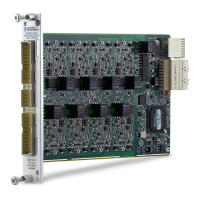© National Instruments | 2-13
NI PXIe-4322 User Manual
Synchronizing Multiple Devices
On PXI Express systems, you can synchronize devices to PXIe_CLK100. In this application the
PXI Express chassis acts as the initiator. Each PXI Express module uses PXIe_CLK100 as its
reference clock. Adding channels from multiple modules to the same NI-DAQmx task will
perform synchronization automatically.
Another option in PXI Express systems is to use PXI_STAR. The Star Trigger controller device
acts as the initiator and drives PXI_STAR with a clock signal. Each target module uses
PXI_STAR as its external reference clock.
Sharing a trigger between multiple devices using PXI trigger lines introduces skew in the trigger
signal, due to the propagation delay of the signal. The NI PXIe-4322 can compensate for that
skew by locking the trigger to a clock (PXIe_SYNC100) that is derived from the reference clock
(PXIe_CLK100). When you lock triggers to a clock, the device responds to those triggers on a
subsequent edge of that clock, rather than immediately. Therefore, skew correction results in
increased latency.
When you add multiple NI PXIe-4322 modules to the same NI-DAQmx task, NI-DAQmx
automatically enables trigger skew correction. To enable trigger skew correction for applications
that use multiple NI-DAQmx tasks, specify which device is the master and which devices are
the slaves using the SyncType DAQmx Trigger property.
Triggering
The following sections provide details about analog and digital triggering of the NI PXIe-4322
module.
Digital Input Triggering
You can configure the NI PXIe-4322 device to start or pause an acquisition in response to a
digital trigger signal from either PXIe_DSTAR <A, B>, PXI_Trig<0..7>, or PXI_STAR. The
trigger circuit can respond to a rising, falling, or level sensitive signal, in one of the following
three modes:
• Start—Begins an acquisition when trigger is met.
• Reference—A certain number of pre-trigger and post-trigger samples are specified around
the trigger.
• Pause—Acquisition is put on hold when trigger is met (level sensitive only).
In addition, the trigger circuit provides a programmable filter to help with noisy trigger signals.
The filter checks that the trigger condition is met for different time intervals before triggering.
The filter can select from 90 ns, 5.12 μs, 2.56 ms, or a custom defined time interval. For
information about configuring digital filters, refer to the NI-DAQmx Help.

